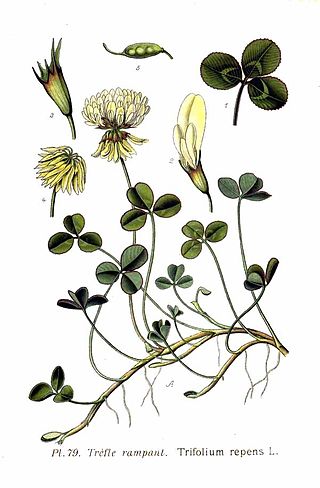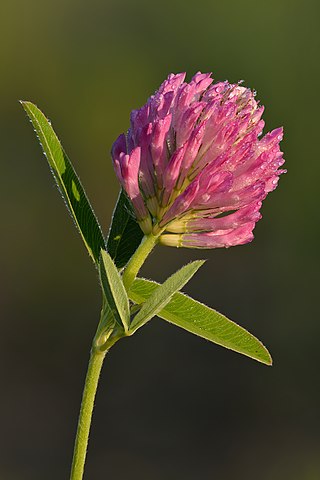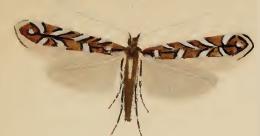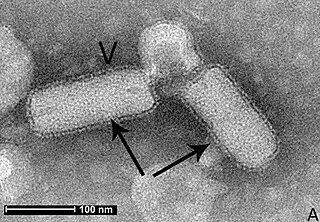
Clover or trefoil are common names for plants of the genus Trifolium, consisting of about 300 species of flowering plants in the legume or pea family Fabaceae originating in Europe. The genus has a cosmopolitan distribution with highest diversity in the temperate Northern Hemisphere, but many species also occur in South America and Africa, including at high altitudes on mountains in the tropics. They are small annual, biennial, or short-lived perennial herbaceous plants, typically growing up to 30 centimetres (12 in) tall. The leaves are trifoliate, monofoil, bifoil, cinquefoil, hexafoil, septfoil, etcetera, with stipules adnate to the leaf-stalk, and heads or dense spikes of small red, purple, white, or yellow flowers; the small, few-seeded pods are enclosed in the calyx. Other closely related genera often called clovers include Melilotus and Medicago.

A shamrock is a type of clover, used as a symbol of Ireland. Saint Patrick, one of Ireland's patron saints, is said to have used it as a metaphor for the Christian Holy Trinity. The name shamrock comes from Irish seamróg, which is the diminutive of the Irish word seamair and simply means "young clover".

Forage is a plant material eaten by grazing livestock. Historically, the term forage has meant only plants eaten by the animals directly as pasture, crop residue, or immature cereal crops, but it is also used more loosely to include similar plants cut for fodder and carried to the animals, especially as hay or silage.

Trifolium pratense, the red clover, is a herbaceous species of flowering plant in the bean family Fabaceae, native to Europe, Western Asia, and northwest Africa, but planted and naturalized in many other regions.
Isoflavones are substituted derivatives of isoflavone, a type of naturally occurring isoflavonoids, many of which act as phytoestrogens in mammals. Isoflavones are produced almost exclusively by the members of the bean family, Fabaceae (Leguminosae).
British NVC community MG5 is one of the mesotrophic grassland communities in the British National Vegetation Classification system. It is one of four such communities associated with well-drained permanent pastures and meadows.

Trifolium medium, the zigzag clover, is a flowering plant species in the bean family Fabaceae. It is similar in appearance to red clover, Trifolium pratense, but the leaflets are narrower and have no white markings and the narrow stipules are not bristle-pointed. The species is native to Europe from Britain to the Caucasus.

Irilone is an isoflavone, a type of flavonoid. It can be found in Trifolium pratense, in Iris unguicularis and in Iris germanica.

Pratensein is an O-methylated isoflavone, a type of flavonoid. It can be found in Trifolium pratense and can have effects for the prevention of atherosclerosis.

Calycosin is an O-methylated isoflavone. It can be isolated from Astragalus membranaceus Bge. var. mongholicus and Trifolium pratense L..

Grapholita compositella, the clover seed moth, is a moth of the family Tortricidae. It is found from Europe to Asia Minor, Mongolia, China and eastern Russia. It is also present in North America.

Phyllonorycter insignitella is a moth of the family Gracillariidae. It is found in all of Europe, except the Balkan Peninsula.

Phyllonorycter nigrescentella is a moth of the family Gracillariidae. It is known from all of Europe except the Balkan Peninsula.

Parectopa ononidis is a moth of the family Gracillariidae. It is known from all of Europe, except Ireland and the Balkan Peninsula.
Micrurapteryx fumosella is a moth of the family Gracillariidae. It is known from Kyrgyzstan.

Pratol is a flavonoid, 4′-O-methylated 4′,7-dihydroxyflavone. It can be found in Trifolium pratense.
Penicillium albidum is an anamorph fungus species of the genus of Penicillium which was isolated from volcanic soils in the south of Chile. Penicillium albidum produces the antibiotic Albidin.

Cytorhabdovirus is a genus of viruses in the family Rhabdoviridae, order Mononegavirales. Plants serve as natural hosts.













